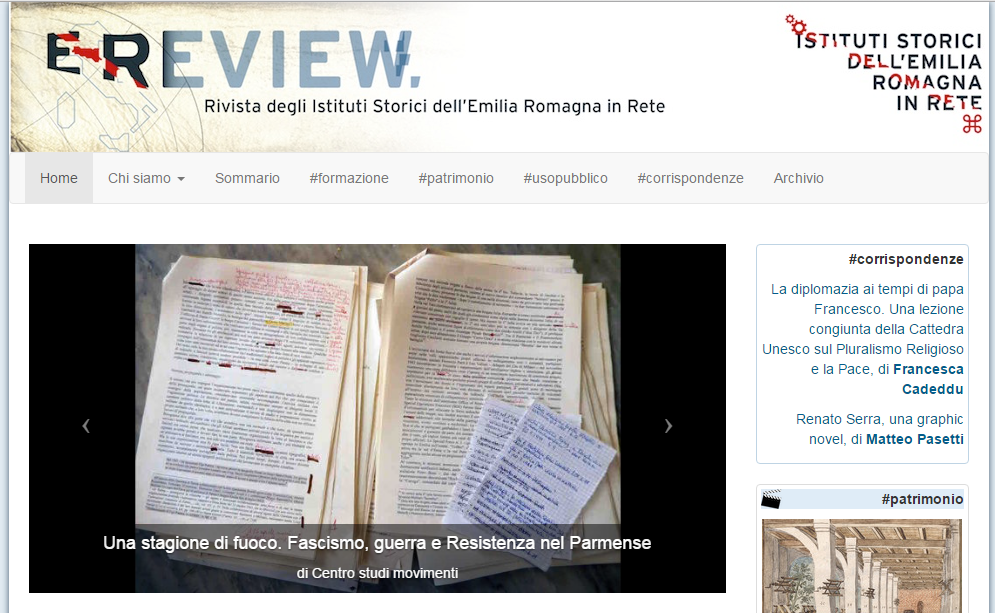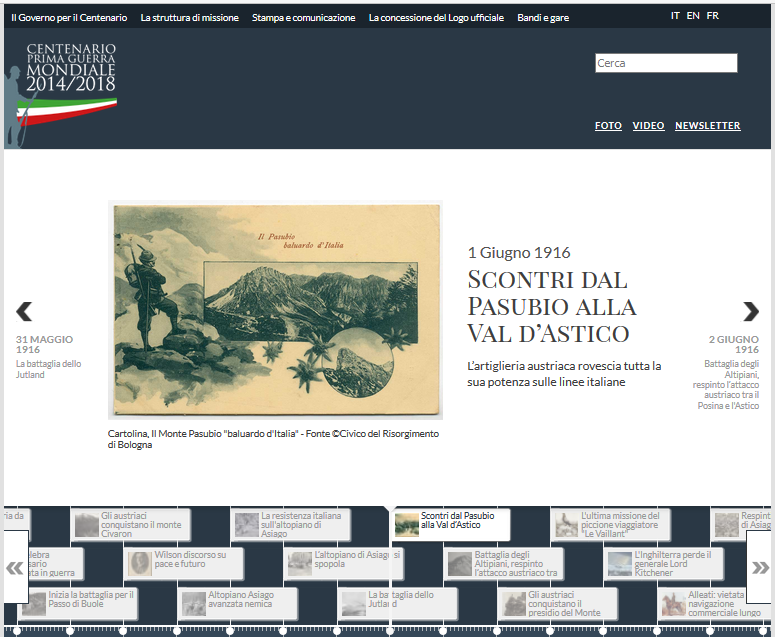History and WEB in Italy (2016)
First update
Updates
2012 (tv) | 2014 (web) | 2016 (web) | 2016 (tv) | 2017 | 2018
by Giulia Dodi
Web pages are increasing more and more every day and internet is becoming one of the major sources of information and communication, used by billion people to search, advertise and share contents about many topics. Internet is a complex area, in which there is a great variety of historical contents and this is highly interesting because there is the opportunity to survey both institutional web sites and popular initiatives. Web is a very useful resource for museum and historical institutes to promote their work, so it’s possible to observe what representation they convey and how they portray events. On the other hand, web is a place where people can express themselves openly without any filter, so it’s interesting to see what’s their attitude toward history, what is their knowledge and how they express it. Thanks to web search engines searching for historical information has become a simple and common operation that provides thousands of results from all over the world in just a few seconds. First of all it’s important to describe different types of historical websites basing on the different contents and interaction with users, site managers and target, among the most commons there are: web sites related to historical institutions, reviews, blogs, didactic portal and digital archive.
Reviews
Historical reviews and magazines on line about contemporary history are great examples of what the dominant topics are and how they are represented to the readers. I will analyze a few examples of online reviews that are well known for the accuracy of their work and completely reliable on sources and information they give and they are significant examples to deliver a complete framework for this research as well.
Young students and new graduated are the most active internet users to display their work and set a network of expertise to discuss and analyze historical issue, that’s the case of Diacronie (http://www.studistorici.com), a quarterly reviews founded by few students in 2009, that publishes both monographic and miscellaneous numbers completely for free. The latest number focused on the relationship between history, historians and territory and the authors were all historian from different countries, because the mission of the reviews is to give an international point of view, with articles written by historians from Europe, North and South America, Asian and Arabian area.
There’s no possibility to comment the articles, but periodically they launch “calls for papers” on a specific topic and everyone is allowed to send their contribution, then there’s a scientific committee of Italian and European historians that check and evaluate every issue in order to ensure a scientific and original debate. Asides from the articles the website offers links to archives, libraries, databases and research centers distinguished by categories (i.e. economic history, social history, science history, national history and so on), which are very useful for students, researchers and teachers that can find much information.
Many Italian universities have an online review in which they publish articles, reviews and debate in order to disclose their works, one of the most notable example is Storicamente (http://storicamente.org), an open access review founded by young researchers of the University of Bologna in 2005. The scientific committee is composed by professors from Italian and European Universities and the review publishes articles, analysis and essays on historical relevant documents, book reviews and didactic materials. The authors are European historians and many articles are available both in Italian and in English but there isn’t the possibility to leave comments, it’s also possible to send papers that will be evaluated and if they worth it they will be published.
Also, research centers find on line reviews useful to emphasize their projects and team up, an example is E-Reviews (http://e-review.it), that connects all Historical Institute of Emilia-Romagna region. It publishes articles about people and facts of the twentieth-century, didactic resources for teachers and students and shares public history projects.
Another example is Novecento.org (http://www.novecento.org), a review about teaching history in school that contains dossiers, papers and videos about how to teach history in an interesting and interactive way, in order to stimulate curiosity in the students and manage to give away complex and composite topics in a simple and engaging way. There’s also a section called “ipermuseum” that contains some attractive exhibit that can be interesting for the students and the teachers to see and discuss during lessons.
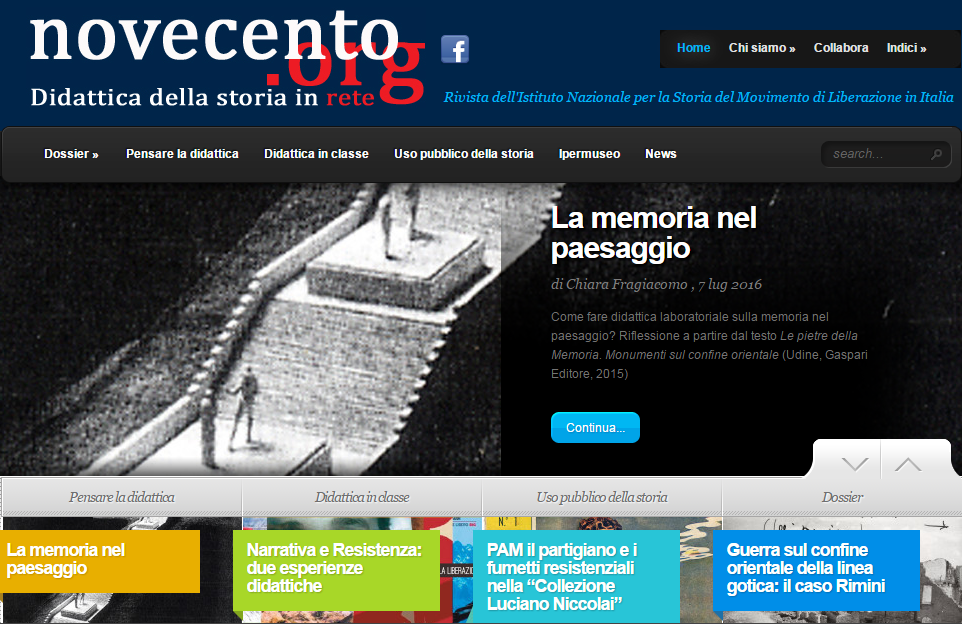
It’s run by Istituto Nazionale per la storia del movimento di liberazione in Italia so it’s very dynamic, with a lot of contents that are periodically updated and it concerns above all Italian contemporary history.
Also, it’s easy to find online reviews that combine history and communications (i.e. Instoria http://www.instoria.it/home/index.htm) about many relevant topics such as environment, art and religion mixing past and present points of view. This kind of reviews are for a generalist audience, not only for experts or students, and try to enlighten the most famous events that the most of the people know, using a simple and catchy point of view.
Institutional websites
Institutions use websites to promote themselves and their activities or to honor some particularly meaningful events, such as the hundredth anniversary of the World War I. That’s probably the most important historical anniversary currently celebrated in Italy and Italian government has created a specific website (http://www.centenario1914-1918.it/it) in which it is possible to find pictures, videos, time lines and maps related to the World War I. There’s a specific bar that allows the search of any events and celebrations concerning this anniversary in Italy, but it’s not possible to ask any information or to express any comment.
The Italian War Museum has a website (http://www.museodellaguerra.it/) that describes the exhibit, gives information about events and celebrations but there isn’t the possibility to interact, leave comments or access to any contents. Also, the Army celebrates the anniversary focusing on the military history and underlining the role that new arms and strategies had during the conflict. There’s a particular web sites (http://www.esercito.difesa.it/storia/grande-guerra), created specifically for the celebration, in which there are photos and videos about the war, posters and leaflets widespread during the conflict. There are sections about equipment, maps that explain where the war took place, time lines that sum up the main battles and a synthesis of the Italian operations. It’s clearly a celebration of the Army and the great effort it had to sustain, without any space for comments.
Generally speaking Italian institutions don’t use their websites to interact with the users, sites are just a way to promote institutional works and initiatives without trying to create a section for cultural debate and public discussion. On the other hand thanks to the web many institutions and archives make available to users a huge amount of materials and put detailed descriptions of their documents on line. An example is Istituto Luce (http://www.archivioluce.com/archivio/), one of the most important footage archive in Europe, that makes available the majority of its documents through its website where it’s possible to see more than 4.000 hours of footage and 400.000 pictures.
RAI, the Italian public television uses its website to make available videos of its more recent shows and on meaningful anniversary (i.e. World War I, massacre of Bologna, the Republic Day) it has created specific documentaries. All these “web doc”, as they are called, contains videos of old Rai TV shows, interviews, statistics, pictures and brief explanations presented in a simple but dynamic way, in which users can analyze aspects they are more interested in and skip what they aren’t concern about, creating their own “plot”.
http://www.cultura.rai.it/webdoc-2giugno/index.html 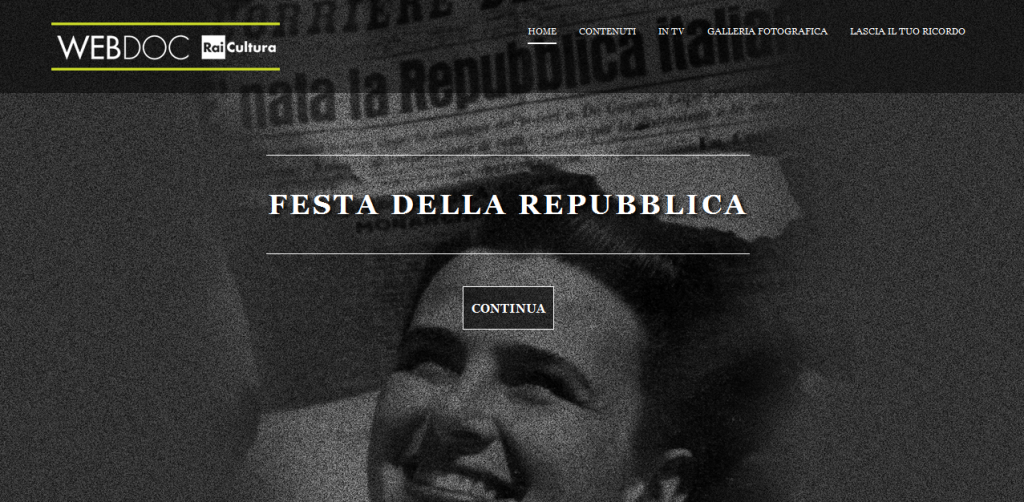
Forum and blogs
Blogs and forums are very popular on the web and some of them focus specifically on history. Many historical blogs have a didactic purpose, they are sort of archives of articles about specific events and summaries of the main topics and they are pointed towards both teachers and students. According to The Web Index, Italy has the lowest level in training teachers to use ICT to improve educations[1], that means that school seldom encourages and provides on line ways to learn, for that reason many students have to find themselves digital materials and blogs seem to be the best source.
Surfing the net it is possible to find simply blogs, run by teachers or enthusiasts that update them in their spare time with videos, detailed studies and biographies of the most popular historical figures. It’s not strange that a blog deal with different periods, sometimes one blog has content about the Romans, Renaissance and twentieth-century, with both national and international history. Theme aspects, content organization and presentations are strictly related to digital knowledge of site managers, sometimes these blogs are catchy and user friendly but it’s more common to see basic interfaces and not well-finished presentations.
A significant example is La storia in un click (History in a click, http://lastoriainunclick.blogspot.it) which is run by a teacher who puts together papers, maps, movies, time lines and other materials about every historical period in order to help students and teacher in learning and teaching history. The interesting aspect is that this kind of blogs talks about history using cartoons, comics and videos that can be more appealing for students and they help understand that history is not just a boring schoolbook. In this case there is no possibility to leave any comments or to discuss topics with other users.
Another interesting blog is Tuttostoria (http://www.tuttostoria.net/), that addresses to students and enthusiasts to give them a simple but clear tools to use in order to learn and study more about history. This portal is divided in four sections: Ancient History, Middle Age, Modern History and Contemporary History, each one of them contains focuses on remarkable people and pivotal events and it’s possible to find books critiques, useful links and museum descriptions. The blog is run by 4 Italian historians that guarantee scientific accuracy of information, but there’s the chance to send articles and collaborate with the editorial staff. There’s space to comment each posts but it’s surprisingly rare to see any comment, although it is a really user-friendly and active blog.
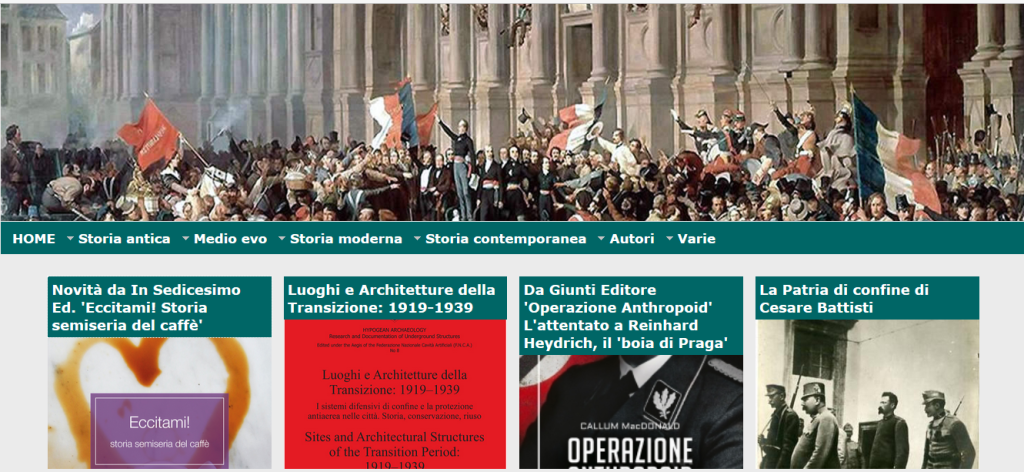
Social networks
Web is an equal environment in which anyone can express their own opinions without any hierarchy and every user can take part in share and spread information. Social networks have increased more and more this possibility for common people to express opinions and judgments about anything and that is especially important for history. In the past people never had a chance like this to express themselves about cultural, historical and political events of the present and the past.
Facebook
The most significant Facebook pages are the one related to historical institutions, TV channels and historical reviews. An excellent example is the page of the Istituto Nazionale per la storia del movimento di liberazione in Italia (National Institute of the Movement for the Italian Liberation) which has almost 2.500 likes and it posts activities of Historical Institutes all over the Italian territory, conferences and exhibits regarding the Italian history of twentieth-century. However, comments and likes are lows and it’s clear the users are above all teachers, enthusiasts and people who are involved in the activities that are advertised, there’s far less interest outside this circle.
Nevertheless, official pages of TV channels are really popular, for instance the page of the pay-television channel History has more than 39 million of likes, which is an outstanding result, and every post has hundreds of likes and sharing. However, comments aren’t so copious and the only posts that generate a debate are the ones regarding Hitler, Nazism, and the Holocaust, in which people comment and share opinions, or most of the times they express their judgment about how some events happened. Rising and developing of Nazi in Germany is the most discussed topic, people share theories on how and why it became so powerful, and sometimes users fight against each other and they even make some connections to the present, but with a very simple and populist approach and without deep historical knowledge.
It’s important to say that this pages don’t share any original content, they just advertise the documentaries and shows their schedule during the day.
Otherwise, it’s possible to find a few pages about historical events entirely created by history enthusiasts with a notable amount of likes and interaction, that the case of La Guerra Fredda in Italia: storia della prima repubblica 1945-1994 (Cold War in Italy: history of the Italian First Republic 1945-1994 https://www.facebook.com/groups/504746816348407) which counts more than 6000 members and it is run by enthusiasts and experts of that period. The purpose of this kind of pages is to post news items, images and videos related to the topic but comments and discussions aren’t always very active.
Youtube
YouTube is an extremely useful instrument to understand what people search and watch the most about history but it’s also a labyrinth in which it’s hard to understand who are the ones that upload videos and which are their sources, as well as the fact that users that leave comments usually have absurd nicknames.
For example, searching for War World II leads to more than 58.000 results, the most of which are documentaries taken from old TV shows, one of the most popular is called La Guerra a colori (War by color) and it’s a 70 minutes video that describes the development of the war from 1939. The documentary has a very traditional structure with a voice over that explains the images and provide all the historical information regarding military and social aspects with a didactic approach. It has more than a hundred comments about Germany, the comparison between Hitler and Stalin and the causes of the war but there’s a very superficial attitude, everybody says their own opinion without referring to specific data, documents or facts.
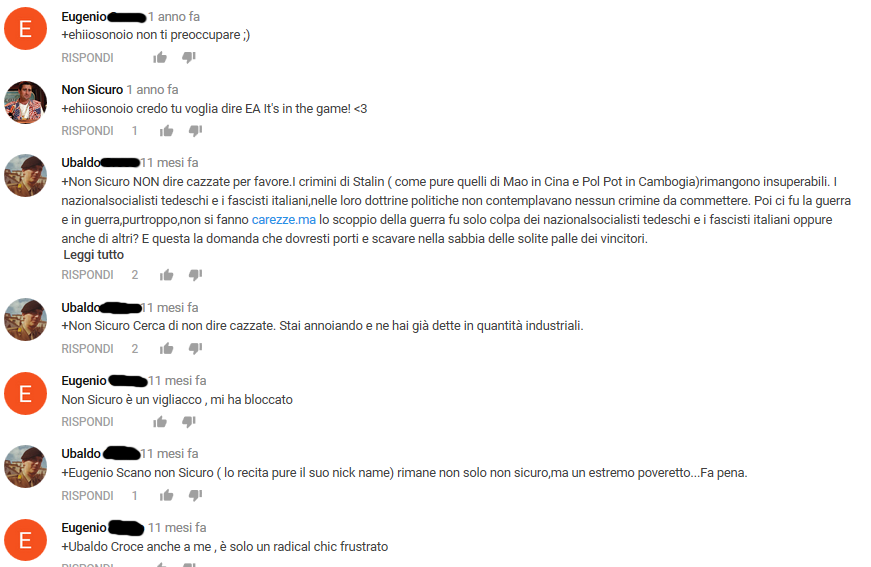
Another very popular video is Mussolini. Soldi, sesso e segreti (Mussolini. Money, sex and secrets) that is taken from an old Italian TV show that aired on the public television, La grande Storia (The Great History) and it has 110.000 views and more than 300 comments. The documentary aimed to show “the secrets” of Fascism and Mussolini’s private life and family, using old repertoire footage and a voice over as a narrator, without any historian interviewed. There is a variety of comments, some make light of Mussolini, others doubt the reliability of the documentary, others criticize Fascism and his representatives but there is no historical knowledge in these comments, their just opinions that doesn’t point out any critical analysis.
Also, videos of theater pièce about historical facts are really popular, Marco Paolini is one of the major Italian actors who plays performances based on twentieth-century Italian history (i.e. Vajont, Ustica, Holocaust and Word Wars) and videos of his plays have thousands of views and comments, regarding above all the acting and the set-up.
Conclusion
To sum up web is full of valiant tools to tell and describe history in interesting and engaging ways, allowing to reach a huge and varied audience all over the world. Websites, social networks, blogs and reviews are means to share information and cultivate passion for teachers, students, experts and enthusiasts which can create networks and increase their knowledge.
Although some topics seem to achieve much more success than others, World War I and II, Nazism, Hitler and Mussolini conveys the interest of many users and all materials related to those issues are always among the most clicked and commented. However, many discussions are about politics, sarcasm and populism rather than historical problems and it’s not rare they and up with users fighting each other. Also, military history is very popular with many former soldiers and experts that compare pictures, statistics and details about equipment and vehicles, analyzing differences and pointing out evolution in military strategies.
The most updated and dynamic web pages are institutional websites which combine many functions and materials but rather than try to interact with users there are like showcase to advertise projects and events. Although also sites and blogs run by enthusiasts are a major source and are always among the most viewed pages in the search engines, proving history is a topic that draw interest from many internet users.

